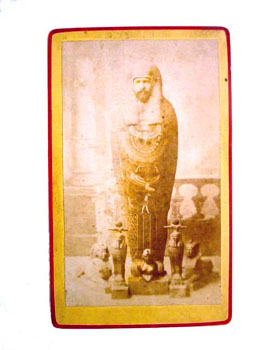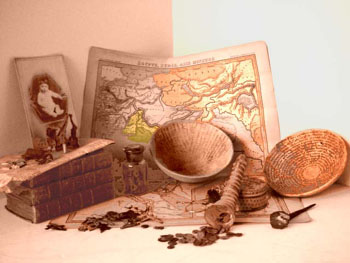Brief background to the curse of the mummies
"Do not print during my lifetime what I'm
about to tell you, but this mummy's sarcophagus was the cause of the
war."
Sir Ernest Alfred Wallis Budge, Curator of Egyptian and Assyrian
Antiquities at the British Museum, 1893-1924.

Any mention of mummies and Egyptian tombs will make the average listener
think immediately of the 'mummy's curse'.
The oldest piece of magic at the Surnateum is a curse tablet dating
from the 5th Dynasty of ancient Egypt, used against tribes living beyond the third cataract. Once inscribed and ritualised,
these tablets were ritually broken and were able to serve as a sort of magical
'mine'.
During the Arab invasion of Egypt in 641 AD, the Arabs were
convinced that strange curses were protecting the ancient sites of
extinct civilisations.
The hieroglyphs - incomprehensible magical writings - looked like
ancient evil curses.
The oldest fantastical writing linked to the mummy's curse was
published in 1699 in the Traité des embaumements selon les anciens
et les modernes (Treatise on Embalming According to the
Ancient and Modern Ways) by Louis Pichier, and texts on this
subject have been published regularly ever since.
The contemporary story closest to us involving a mummy's curse, or,
more exactly, a sarcophagus, is known under the reference CAS 25542. The
oldest document which the Surnateum possesses on this subject is an
article frp, The Horoscope magazine published by Rollo Ireton
in 1904 (p. 236 ff), which itself seems to have been taken from the
pages of the Daily Express.
In the same magazine there is an article entitled Lucky and
Unlucky Objects, a subject dear to the hearts of the Surnateum's
personnel.
A blend of eyewitness account and urban legend, the story
begins in 1880, when a young gentleman by the name of Douglas Murray
consulted a well known palm-reader called Cheiro (the pseudonym of
Count Louis
Hamon 1860-1936). The wizard, frightened by what he saw in the hand
of his client, predicted that a revolver would blow up in his hands
and that he would suffer an amputation. He added that Murray would win
a sarcophagus in a lottery and that bad luck would hound him and
everyone involved in the acquisition of the
sarcophagus. Murray openly scoffed at the palmist's predictions and
promptly forgot the story - but Cheiro did not.
A year or so later, the young gentleman travelled to Egypt where his
drogman (guide) told him about a superb sarcophagus for sale.
It had
apparently once belonged to a priestess of Amon-Ra, who had died at Thebes
around 1600 BC. The mummy had long disappeared, but the
cover of the box had a representation of her pretty face. Despite
feeling a rather unpleasant sensation about the object, he acquired it
and took it back to his hotel. Two of his friends there marvelled at
the sarcophagus and it was decided to draw lots for it. Murray
won the draw. He had the item packaged up and sent to England.
A few days later, during shooting practice along the Nile,
a revolver blew up in his hands and his arm had to be amputated in order to prevent gangrene. Upon returning home, his two
friends fell ill and died.
When Murray returned to England, he found the package - still
wrapped up - in the hallway of his home. Later, he wrote: "If
such a thing is possible, when I looked at the face drawn on the cover
of the sarcophagus,
its eyes seemed to come back to life and looked at me with such
hatred that my blood ran cold."
Convinced of the object's evil power, he gave it to a friend.
Shortly after she took the box to her home, her mother fell down the
stairs and died; her fiancé left her and all of her family pets
died.
She, in turn, became seriously ill and returned the sarcophagus to David Murray.
Having decided to sell it, he had the cover photographed by a
professional photographer. The following week, the photographer called
him in a panic and told him that he could see in the photos he had
taken the very real and evil face of the princess.
He gave him one of the photographs. A short time later, the
photographer died of an overdose of sleeping pills, apparently after
destroying the photos, one of which showed his own face on the cover.
The Surnateum has one copy of this incredibly rare document.
To be rid of it, Douglas Murray donated it to the British Museum.
Several deaths followed, bringing the number of victims up to 13. Strange phenomena were observed in the Egyptian section of the museum.
The guard reported an apparition with a yellowish-green face sitting
on the lower part of the sarcophagus, which then glided silently
towards him.
He fled, followed by the spectre before it finally disappeared into
thin air.
The British Museum had the sarcophagus removed from the exhibition
halls at the advice of the Collector. The Collector commissioned an
inquiry and found one of the photos that had escaped destruction.
In 1912, a groundless rumour went around that the mummy had been
aboard the Titanic. There was indeed a mummified object aboard
the Titanic, but it was the Demon
Hand talisman.
According to another equally wrong rumour, a cursed diamond - the
Hope diamond - had also been aboard the Titanic.
In 1921, two mediums called Wyeth and Neal carried out an exorcism.
They claimed that the priestess was a 'clairvoyant' capable of reading
omens in a silver cup and that she had lived in a dark time when
embalmed corpses were used in black magic rites. To protect herself
from desecration, the priestess Amon-Ra had the sarcophagus guarded by
the tortured spirit of a servant. The exorcism rite seems to have
worked, because since then no other disaster seems to have been
provoked by the keeper. All of this must be viewed with suspicion
since Amon-Ra has nothing to do with the worship of the dead. There
are several versions of this legend.
In actual fact, the cover of the sarcophagus was donated to the British Museum
by A.F. Wheeler in 1899 and the curse was not considered real.
Moreover, there had never been a lower part to the sarcophagus. However, the Curator of the Surnateum has his doubts about whether the
personnel of the British Museum are acting in good faith since he
possesses proof that the story is authentic - even though the legend is
hard to separate from the facts and even though it is possible
to be mistaken about the identity of the sarcophagus.
 The
discovery of the intact tomb of Tutankhamen in 1922 and the sudden
death of George Herbert, the fifth Earl of Carnavon, in April 1923 and
22 other individuals in the six years that followed the opening of the
tomb revived the debate. Readers will recall that Lord Carnavon was
stung on the cheek by a mosquito. While shaving he scratched the bite,
causing it to become re-infected. He died of pneumonia in Cairo on 5
April 1923.
The Daily News reported that all the lights in Cairo went out
at the moment of his death.
The
discovery of the intact tomb of Tutankhamen in 1922 and the sudden
death of George Herbert, the fifth Earl of Carnavon, in April 1923 and
22 other individuals in the six years that followed the opening of the
tomb revived the debate. Readers will recall that Lord Carnavon was
stung on the cheek by a mosquito. While shaving he scratched the bite,
causing it to become re-infected. He died of pneumonia in Cairo on 5
April 1923.
The Daily News reported that all the lights in Cairo went out
at the moment of his death.
His last words were reportedly: "Pharaoh, I am returning to you!"
For more information on this subject, we would advise you to read
the excellent book in French entitled La
Momie, de Khéops à Hollywood (published by Editions
de l'Amateur).
The Curator would like to point out that there are other such curses, including
the curses of Peruvian mummies; he encourages you to
examine the case of Quena Ollantay,
in the Department of Prophecies and Apocalypses.
Note: Since the then Collector closely supervised the
exhumation of Tutankhamen and the pillaging of the tomb, the Surnateum
possesses a full series of copies of L'Illustration, a magazine
which focused on this subject for several years. These documents can
be consulted in the Department of Forgotten Knowledge and Cursed Books
during ordinary opening hours.
The slaughter that followed the violation of the burial place fully
justifies the existence of the Surnateum. The Surnateum's research
team carried out many expeditions to Egypt between 1920 and 1930.

